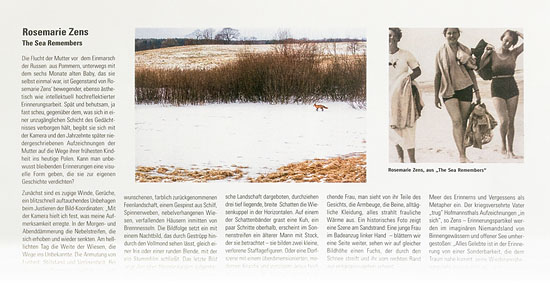The Sea Remembers – Review in Photonews
 I am glad to communicate the review on „The Sea Remembers“ by Andrea Gnam in
I am glad to communicate the review on „The Sea Remembers“ by Andrea Gnam in
Photonews, Zeitung für Fotografie, Nr. 4/15.
Initially there were brisk winds, smells, an unease that emerged suddenly as she adjusted the image coordinates: “I photographed what caught my attention. The wisps of fog that rose and fell again at dawn and dusk. The expanse of the meadows in the bright light of day, the paths into the unknown. The impression of freedom, standstill and lostness. On closer scrutiny I recognised what I had overlooked at first: how something violent breaks in, how easily images become threatening.” One of her mother’s sentences used at the start of the first photo-sequence describes the existential aspect of the situation. “Here in the middle of the landscape, where should I go?” It is the kind of early, elementary threat that occurs in Grimm’s’ fairy tales. And in many of the images we encounter an enchanted, colourfully reserved fairy landscape, a web of reeds, cobwebs, fog-shrouded meadows, dilapidated houses surrounded by nettles. The sequence of images begins with a night image in which the full moon is visible through shrubbery, like the iris or round lens at the end of a silent movie. The last image shows the moon risen above power lines with several branches reaching up towards it like outstretched arms.
Sometimes a tear inscribed in the images works itself to the surface: in a two-sided/-page picture a slightly arched meadow landscape appears like a symbol out of kilter. With sparse shrubbery and several gaunt trees at the sides, presented to view like a heroic landscape, the dome of the meadow is traversed horizontally by three broad low-lying shadowy bands. A cow is grazing on one of these bands of shadow, and a few steps above it in the band of sunlight we see an older man with a stick who is observing the cow – making up two small lost staffage figures. Then there is a village scene with a high modern larger-than-life crucifix and a tiny Jesus figure in front of an electricity pylon, all of which combine into a kind of machine on the surface of the image.
The black-and-white photographs from the family album inserted rhythmically into the sequences of images comply with the pull of memory. These are largely cropped (or actually taken that way?) so that they correspond to what a much-loved child would like to recall: a woman laughing, parts of her face visible, the crook of her arm, her legs, everyday clothing, all radiating female warmth. A historical photograph shows a scene on a sandy beach: on the left a young woman in a bathing suit – if we leaf on to the next page we see, at the same level, a fox roaming through the snow and apparently going towards her from the right edge.
This wonderful publication, enclosed by the photographer’s reflections and extracts from the accounts written by her mother – who would seem to have been a fun-loving and brave woman – can be read at several levels. The title punched out of the poster cover (if the book with the sewn binding is unwrapped a map of the places can be found on the inside of the French flap dust jacket) introduces the metaphor of the sea of memory and of oblivion. According to Zens, her war-disabled father “carried” Hofmannsthal’s notes “within him” – particles of memory are buffered about in the imagined no-man’s land of inland waterways and open sea: “In our memory everything that we lived through takes on a strangeness like in a dream; re-approaching it is both attractive and off-putting – mixing death and life like sweet and salty water …”
Andrea Gnam in Photonews 4 (2015) www.photonews.de (Translated by Pauline Cumbers)
Rosemarie Zens: The Sea Remembers. Landschaft und Geschichte. Kehrer Verlag Heidelberg 2014, 144 pages with 50 illustrations, ISBN 978-3-86828-505, $ 50
2015-04-07